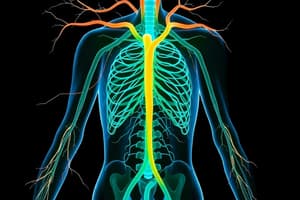Podcast
Questions and Answers
Which of these glands is part of the endocrine system?
Which of these glands is part of the endocrine system?
- Stomach (correct)
- Pancreas (correct)
- Liver
- Kidney
What is the role of insulin?
What is the role of insulin?
Regulates blood sugar levels
The SA node is known as the natural pacemaker of the heart.
The SA node is known as the natural pacemaker of the heart.
True (A)
What distinguishes arteries from veins?
What distinguishes arteries from veins?
What are the two types of synapses?
What are the two types of synapses?
What is the main function of red blood cells?
What is the main function of red blood cells?
The types of bone marrow are red and ______.
The types of bone marrow are red and ______.
What is one function of the skin in maintaining homeostasis?
What is one function of the skin in maintaining homeostasis?
Match the key cellular structures with their functions:
Match the key cellular structures with their functions:
What are the three anatomical planes?
What are the three anatomical planes?
Which body cavity is associated with the heart?
Which body cavity is associated with the heart?
Flashcards
Endocrine Glands
Endocrine Glands
Organs that produce and secrete hormones directly into the bloodstream.
Hormones
Hormones
Chemical messengers that travel through the bloodstream to target cells, causing specific responses.
Pancreas
Pancreas
Endocrine gland that produces insulin and glucagon, regulating blood sugar.
Adrenal Glands
Adrenal Glands
Signup and view all the flashcards
Cardiac Conduction
Cardiac Conduction
Signup and view all the flashcards
SA Node
SA Node
Signup and view all the flashcards
Arteries vs. Veins
Arteries vs. Veins
Signup and view all the flashcards
Neuron Parts
Neuron Parts
Signup and view all the flashcards
Glial Cells
Glial Cells
Signup and view all the flashcards
Homeostasis
Homeostasis
Signup and view all the flashcards
Study Notes
Endocrine System: Gland and Hormone Functions
- Review the pancreas, adrenal glands, stomach, anterior pituitary, thyroid gland, and hypothalamus.
- Understand which hormones each secretes (e.g., insulin, glucagon, adrenaline, gastrin, TRH).
- Focus on each hormone's role in maintaining homeostasis, metabolism, and stress response.
Cardiac Conduction System Anatomy and Function
- Familiarize yourself with the heart's electrical conduction system (SA node, AV node, Bundle of His, Purkinje fibers).
- Understand the "natural pacemaker" role.
- Examine the functional advantages of red blood cell shapes and features, including surface area for oxygen transport.
Blood Vessels and Circulation
- Learn to distinguish arteries and veins based on structural characteristics (e.g., presence of valves, depth in body) and functions (e.g., blood flow direction).
- Review terms like "aorta," "vena cava," and oxygenation status.
Nervous System Components and Cell Types
- Identify key neuron parts (dendrites, soma, nucleus, myelin sheath).
- Understand their roles in signal transmission.
- Understand the support roles of glial cells versus neurons, including insulation and protection.
- Differentiate between chemical and electrical synapses.
- Review the concept of an action potential in signal propagation.
Heart Anatomy: Valves and Chambers
- Recognize key heart structures, including the mitral and tricuspid valves, and the right and left atria and ventricles.
Red Blood Cells (Erythrocytes)
- Review red blood cell shape, function, and classification.
Skeletal System and Bone Structure
- Know the difference between red and yellow marrow locations, and types of bones (long, flat, irregular).
Endocrine Glands in Context
- Be familiar with endocrine glands' locations and their relationships to other organs, especially adrenal glands and kidneys.
Homeostasis and Skin Functions
- Understand homeostasis and the skin's functions, including vitamin D synthesis, thermoregulation, and dehydration prevention.
Cellular Components and Functions
- Review the structure and function of key organelles (mitochondria, endoplasmic reticulum, plasma membrane).
Tissues and Anatomical Planes
- Differentiate muscle, nervous, epithelial, and connective tissues.
- Recognize sagittal, coronal, and transverse planes for anatomical orientation.
Body Quadrants and Cavities
- Identify locations of major body cavities (cranial, thoracic, abdominal, vertebral) and body quadrants for abdominal regions.
Studying That Suits You
Use AI to generate personalized quizzes and flashcards to suit your learning preferences.
Related Documents
Description
This quiz covers essential components of the endocrine and circulatory systems, including glands, hormones, and the heart's conduction system. It highlights the functions of various hormones and the anatomical features of blood vessels. Test your knowledge on these vital systems that maintain homeostasis and support bodily functions.




